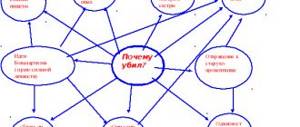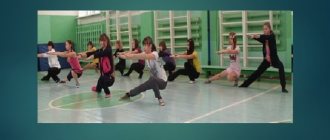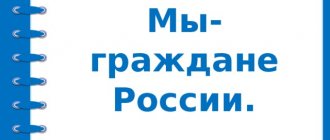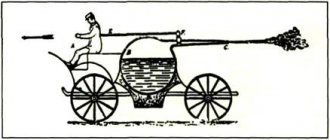History lesson summary with presentation on the topic: The beginning of the Great Patriotic War (9th grade)
Summary of a history lesson in a correctional school, grade 9
Author: Polyakova Svetlana Nikolaevna, history teacher OKSKO "KSKO school", Kursk. Description of work: I propose a script for a lesson on the history of Russia for a special (correctional) school of the VIII type.
This is one of the options for presenting material about the beginning of the Great Patriotic War. The lesson is designed for 9th grade students. Lesson summary on the topic: The beginning of the Great Patriotic War
Purpose: to consolidate students’ knowledge on the previous topic, to form their idea of the course of military operations in the initial period of the Great Patriotic War. Objectives: Educational: • consolidate students’ knowledge on the topic: the Soviet Union at the beginning of the Second World War; • provide information that the war with Germany was just and liberating in nature on the part of the USSR; •tell about the reasons for the failures of the Red Army in the initial period of the war; • explain the concept of “occupy”, “division”. Corrective and developmental: • correct memory, attention, thinking, speech; continue to develop the ability to work with a historical map and analyze the material being studied. Educational: • to form in students patriotic qualities, pride in the feat of their grandfathers, who defended the freedom and independence of the Motherland in the most difficult conditions. Equipment: PC, projector. Didactic material: textbook: Puzanov B.P., Borodina O.I., Sekovets L.S., Redkina N.M. History of Russia: textbook. for 9th grade. specialist. (correctional) education. VIII type institutions. – M.: Humanite. ed. VLADOS center, 2005, historical map (Political map of the USSR), portrait of Stalin, presentation “The Beginning of the Second World War,” audio recording of Yu. Levitan (radio address to the Soviet people). Lesson type: combined. During the classes. I.Org. moment. Greeting students. II. Main part. 1. Checking the D/z. Conversation on the questions:
-When did the Second World War begin?
-Which territories went to the USSR? -Show them on the map. -When did the Red Army units cross the border of Finland? -Prove that the USSR was not ready for war with Finland. -How long did this war last? -Why did all the countries of the world condemn the USSR? Working with cards (for some students): Card No. 1 Continue the phrase: The war with Finland began because... Card No. 2 Continue the phrase: The war with Finland ended in victory... Card No. 3 Continue the phrase: Snipers are... 2. Updating knowledge, announcement of a new topic. -Let's remember why the USSR signed a non-aggression pact with Germany? (To delay the start of the war) -The war between Germany and the Soviet Union was approaching. Hitler concentrated enormous military forces and equipment near the western border of the USSR. Stalin gave orders not to enter into any conflicts with German border guards. He hoped that the start of the war could still be delayed. But his hopes were not justified. A slide with the topic of the lesson appears on the screen.
- I suggest you find out how it was.
3. Studying new material. Listening to an audio recording of Yu. Levitan. View the illustration in the textbook on page 166 A slide appears on the screen with a photo of German soldiers crossing the state border of the USSR.
-Several times Soviet intelligence officers warned Stalin that Germany was gathering troops to the Soviet border.
The outstanding Soviet intelligence officer Richard Sorge sent a report about the time when Germany was going to attack the USSR. But Stalin did not want to believe these reports. A slide appears on the screen with a photo of Soviet border guards on patrol.
The photograph is interesting because it was taken for a newspaper at one of the outposts on the western border of the USSR on June 20, 1941. -The German command developed a plan for an attack on the Soviet Union.
This plan was called "Barbarossa". In accordance with it, Germany wanted to conduct a lightning war. That is, to suddenly attack the USSR and occupy significant territory within several months. And then establish your own military control system on the occupied territory. -I said the word occupy - this is a new concept. It can be replaced, captured with a word. Students read the new word on page 167. A slide appears on the screen with a photo of the first day of the war and the first casualties (soldiers of the 101st Light Infantry Division).
—
A division is a large military unit. -At dawn on June 22, 1941, Germany attacked the Soviet Union. This attack was treacherous, without a declaration of war. The hum of hundreds of aircraft, the roar of tanks and artillery shots broke the silence of the early morning. The German army launched an offensive along the entire border of the Soviet Union - from the Black Sea to the Baltic Sea. Now read the three paragraphs from the top on page 163 and answer the question: Was the Soviet army ready for war? A slide appears on the screen with photos of captured Soviet women soldiers.
-This photo was taken five days after the start of the war.
A slide appears on the screen with a photo of German dive bombers. -Hitler chose three main directions for the advancement of his troops: Moscow, Kyiv and Leningrad (shown on the map). In the first months of the war, the Red Army lost hundreds of thousands wounded, killed and missing. Thousands of tanks and planes were destroyed by enemy aircraft. A slide appears on the screen with a photo of the crashed Soviet Chaika I-153 fighters.
-On the first day of the war, Stalin was so confused that it was not he himself who addressed the people, but the Chairman of the Council of People’s Commissars, Molotov.
He said that the Soviet people are obliged to withstand this fight against the enemy. “Our cause is just. The enemy will be defeated. Victory will be ours!" -The Soviet government announced general mobilization. Thousands of people came to military registration and enlistment offices to ask to be sent to the front. The entire population of the country was ready to defend their Fatherland. Martial law was declared in all border areas. A slide appears on the screen with a photo of Soviet girls volunteers heading to the front.
-What measures were taken by the Soviet government to manage the fronts of the Red Army?
Read on page 167, write it down in your notebook. -The Red Army was retreating all the time. It seemed that Hitler's plan for the lightning takeover of the USSR was coming true. But the German command was faced with the courage and heroism of Soviet soldiers and officers. Despite the retreat, in battles with the Nazis, Soviet soldiers showed incredible courage, perseverance and determination to survive this war and prevent the enemy from capturing our Fatherland. A slide appears on the screen with photos of dead Soviet soldiers, as well as civilians. -This is how the nationwide Great Patriotic War of the Soviet people against the Nazi invaders began. It was the most terrible and difficult war of the 20th (20th) century. The war continued for four long years. 4. Phys. One minute Students do eye exercises. 5. Primary consolidation of the material. Textbook questions on page 168 Exercise in the notebook:
on the board you see the names of cities.
Write down those that Hitler chose to advance his troops. Moscow, Leningrad, Stalingrad, Kursk, Kiev, Orel, Belgorod 6. Working with text for additional reading on pp. 168-169 Reading independently. III. Final part. 1.Grading.
2.D/z (pp. 162-169). 3. Summing up. Presentation on the topic: The beginning of the Great Patriotic War
We recommend watching:
History puzzle lesson with presentation, 5th grade. Ancient East Synopsis of a social studies game lesson with presentation, 7th grade Research work with presentation, 6th grade. First World War Intellectual quiz for high school students on law
Similar articles:
War song lyrics for children



